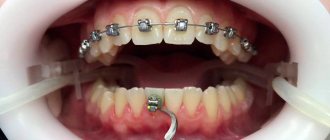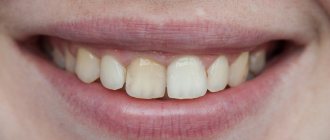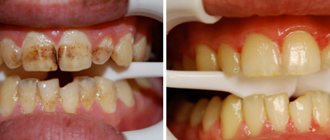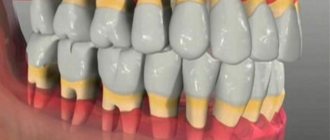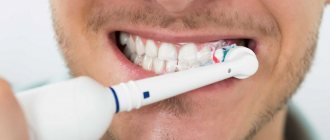Today, pharmacies and supermarkets are literally overflowing with various oral care products. There is a great variety of toothpastes, gum gels, flosses and other products on the shelves. One of the consistently popular products in this category is mouthwash.
Most dentists are confident that to prevent caries and other dental problems, it is enough to simply follow the rules of brushing - use toothpaste at least 2 times a day and carefully remove food debris with a special floss. Ordinary citizens usually use rinses more to eliminate bad breath or to prevent gum inflammation.
Whether it is necessary to buy a mouthwash or whether you can do without it is an ambiguous question, to which we will try to find an answer in the framework of this article.
What types of rinses are there?
A huge number of rinses that we see on the market can be classified into:
- hygienic - they have a rather cosmetic effect and are designed to eliminate bad breath;
- medicinal – these products already serve to eliminate certain dental diseases.
As for medicinal rinses, they are divided into the following types, depending on functionality:
- Against plaque and to prevent the development of gingivitis. These compounds can slow down the growth of bacteria in the oral cavity. They consist of antiseptics such as chlorhexidine and triclosan.
- Against the occurrence of caries. They contain increased fluoride content, which strengthens teeth and prevents caries from developing.
- Against the formation of tartar. Mouthwashes in this category contain calcium citrate and prevent the accumulation of hard dental plaque.
Glossitis
Glossitis is an inflammation of the tongue, which can be either infectious or non-infectious in nature and be an independent disease or a symptom of another disease. According to the nature of its course, it can be acute and chronic, as well as superficial and deep. Acute inflammation occurs suddenly and can be caused by allergies or trauma to the tongue, while the chronic form is recurring and is a consequence of infection or untreated acute glossitis. Superficial glossitis affects only the upper layers of soft tissue, while deep glossitis can affect the thickness of the tongue, its muscles and cause ulcers.
In addition to this classification, there are other types of glossitis. The most common ones are:
- Catarrhal. It is accompanied by a thick coating on the tongue and limited mobility, as well as the appearance of bright red areas and a burning sensation.
- Ulcerative. It is characterized by the presence of a dark gray coating on the tongue, under which painful bleeding erosions form.
- Phlegmonous. It is found at the bottom of the mouth and causes acute inflammation in the neck area.
– Desquamative. Affects the mucous membrane of the back of the tongue and is considered a common symptom of stomach diseases.
– Folded. It appears as folds on the back of the tongue, is a congenital anomaly and does not cause much concern.
- Diamond-shaped. It is a congenital disease that is diagnosed by the presence of diamond-shaped papillae on the back of the dorsum of the tongue. In the absence of complaints, special treatment is not required.
Causes of glossitis
Factors that provoke inflammation of the tongue can be very different - from mechanical damage to microorganisms and poisoning.
- If it is viral in nature, the cause of the disease may be a bacterial infection or a herpes virus.
- One of the common causes is constant burns of the tongue from very hot drinks or hot (spicy) foods. Heavy smokers and people who abuse alcohol are also at risk.
- If the oral cavity has decayed teeth with sharp edges, as well as poor-quality fillings and dentures, this can cause permanent injury to the tongue and provoke inflammation.
- Failure to comply with personal hygiene rules and the use of other people's toothbrushes, which also causes the development of this disease.
- Glossitis can become a symptom of poisoning with heavy metal salts.
- Inflammation of the tongue is sometimes caused by allergic reactions to the composition of toothpastes, mouthwashes and other hygiene products.
For information about prices and treatment times, call:
+7
or fill out the feedback form:
Common manifestations of glossitis
The symptoms of this disease are determined by the cause of its occurrence (infectious or non-infectious), as well as the specific variety. There are also general manifestations characteristic of inflammation of the tongue in all its types:
– Redness, burning and discomfort. These are the most typical symptoms indicating glossitis. The tongue becomes bright red and slightly swollen, which also affects diction. The patient experiences discomfort not only during conversation, but also when eating. Taste sensations may change and salivation may increase.
– Swelling, tenderness and erosion. These manifestations are characteristic of acute glossitis caused by pathogenic microflora. Ulcers appear on the tongue, which open and form erosions. Infectious glossitis is characterized by severe swelling, severe redness and difficulty eating.
- Abscesses. The appearance of acute throbbing pain, increased salivation, uneven enlargement of the tongue and soreness indicate advanced inflammation and the development of an abscess. One of the most serious complications of glossitis is phlegmon - a purulent process that can spread to the bottom of the mouth and neck.
How to treat glossitis?
If left untreated, glossitis becomes chronic, which is manifested by persistent swelling, changes in the color and structure of the tongue, impaired diction, and can subsequently cause serious complications. At home, to improve the condition, you can rinse your mouth with herbal infusions (chamomile, sage, basil), avoid solid foods and hot drinks, but the treatment itself must be done in a dental clinic.
The general treatment regimen for glossitis includes: 1) sanitation of the oral cavity, 2) rinsing the mouth with antiseptic solutions, 3) applications with various ointments, 4) treating the affected area with oil solutions, 5) taking vitamins, minerals and drugs that stimulate the immune system. If glossitis is a symptom of another disease, then treatment should be aimed at identifying and eliminating the pathology that provoked it.
The main prevention of glossitis is the elimination of factors that can provoke it. It is necessary to maintain oral hygiene, limit the consumption of spicy foods and hot drinks, quit active smoking and strong alcoholic beverages, as well as regular dental examinations and see a doctor at the first signs of glossitis.
What are the benefits of mouthwashes?
Of course, not a single product of this type can protect 100% from dental or periodontal diseases. However, they do a good job of fighting bacteria and freshening your breath. Thanks to herbal extracts, many of them quickly relieve gum inflammation.
Other benefits of using mouth rinses include:
- These are 100% ready-to-use solutions that are ideal for express care of teeth and gums.
- As a rule, rinses have a rather pleasant smell and taste, which creates a certain comfort when using them.
- Such products have a deodorizing effect, allowing you to maintain fresh breath almost all day long. Fragrances are usually mint or menthol.
- Therapeutic and prophylactic agents are characterized by anti-caries, anti-inflammatory and disinfectant effects. They can also significantly reduce tooth sensitivity.
- Mouthwashes that do not contain alcohol can be used by children aged 6 years and older, pregnant women and those with severe allergies to alcohol.
- Anti-caries products, due to fluorine and calcium, help strengthen the enamel. Such solutions can be used regularly.
Recently, due to the spread of infections of viral etiology, including respiratory viral diseases, the question arises: does chlorhexidine digluconate (CHB) have antiviral activity?
Chlorhexidine is used in the form of salts, mainly as bigluconate. CHB is most soluble in water and alcohols, and hence this form is used to make antimicrobial agents. CHB is a universal skin antiseptic that kills many pathogenic microorganisms, but is safe for humans. Currently, in clinical practice, CHB is preferred not only when treating the skin (hands, surgical field), but also as an oral antiseptic. The therapeutic activity and safety of CGB have been studied in dozens of international clinical studies. It is characterized by antimicrobial activity against gram-positive and gram-negative bacteria, fungi, and also negatively affects the causative agents of certain viral infections.
Many scientific papers have been published studying the antiviral activity of CGD. At the same time, some sources confirm the virucidal effect of CHB, while others question this effect in relation to some viruses.
Karpinski T.M. and Szkaradkiewicz AK in an article describing a wide range of pharmacological activity of CHB, indicate that under the influence of CHB, complex viruses surrounded by a lipoprotein shell (herpes simplex virus, HIV, influenza virus, cytomegalovirus) are quickly inactivated [1]. Wood A. and Payne D. in their study confirm the inactivating effect of chlorhexidine on herpes simplex virus type 1 and HIV type 1 [2].
In addition, Bernstein D. et al. in a study of the antiviral effectiveness of Peridex mouth rinse (in vitro), containing 0.12% CHB, they proved the virucidal activity of the drug against several viruses: herpes simplex (HSV), cytomegalovirus (CMV), influenza A, parainfluenza and hepatitis B (HBV) ) and the ineffectiveness of the drug against the polio virus [3]. Antiviral activity increased with increasing time of exposure of the drug to the mucous membranes of the oral cavity. Thus, it has been suggested that CGB exerts an antiviral effect by targeting the enveloped herpes simplex, influenza A, parainfluenza, hepatitis B, and cytomegalovirus viruses, but has no effect on the nonenveloped poliovirus.
CHB acts at the level of the cell membrane, increasing its permeability [4]. First of all, it destroys the capsid - the protein shell of the virus.
A new study conducted in 2021 confirmed the susceptibility of the SARS-CoV-2 virus to the effects of a 0.05% CHB solution. Viral culture testing showed that the SARS-CoV-2 virus was undetectable after a 5-minute incubation at room temperature (22°C). This conclusion was reached by scientists from the Medical University of Hong Kong, whose work was published in the scientific journal The Lancet Microbe [5].
Based on the above, we can conclude that CHB has a certain antiviral activity against complex (enveloped) viruses and is currently one of the main antiseptics in the range of drugs for treating the oral cavity, skin, and hands of medical personnel.
- Karpinski T.M., Szkaradkiewicz AK Chlorhexidine — Pharmaco-biological activity and application. European Review for Medical and Pharmacological Sciences, 2015; 19: 1321-1326.
- Wood A, Payne D. The action of three antiseptics/disinfectants against enveloped and non-enveloped viruses. J Hosp Infect 1998; 38: 283-295.
- Bernstein D., Schiff G., Echler G., Prince A., Feller M., Briner W. In vitro virucidal effectiveness of a 0.12%-chlorhexidine gluconate mouthrinse. J Dent Res. 1990 Mar; 69(3):874-6.
- Zverkov A.V., Zuzova A.P. Chlorhexidine: past, present and future of one of the main antiseptics. Scientific and practical journal “Clinical microbiology and antimicrobial chemotherapy”. – Smolensk: Interregional Association of Public Associations “Interregional Association for Clinical Microbiology and Antimicrobial Chemotherapy”, 2013. – T. 15, No. 4, pp. 279-285.
- Chin A., Chu J., Perera M. et al. Stability of SARS-CoV-2 in different environmental conditions. Lancet Microbe 2020; published online, April 02, 2021.
Technologist for drug development at Retinoids JSC Krot S.L.
Seal
Cons of mouthwashes
Hygienic products are not mandatory for use, since cheaper and no less effective analogues are plain water, herbal infusions or green tea. Such rinses, as a rule, simply dull bad breath, but do not eliminate the causes of its occurrence. In addition, some products can stain tooth enamel, which, of course, is unlikely to benefit it.
It is also important that many of them contain alcohol, which means they cannot be given to children, much less swallowed. Since some of the standard contained in such products still enters the bloodstream, being absorbed from the oral cavity, mouthwashes are contraindicated for patients with alcoholism.
Despite the fact that these products effectively destroy microbes, they can cause inflammation and dry mucous membranes. If this occurs, use of the rinse aid should be stopped immediately.
Is it possible to use chlorhexidine alone during endodontic procedures?
Pulpitis and apical periodontitis develop when bacteria penetrate deep into the dentin or into the root canal space of the tooth. The effectiveness of their treatment (both in the short and long term) depends on how complete the elimination of microorganisms from the root canal is, and whether re-infection can be avoided.
Any endodontic intervention begins with a diagnosis, the decision to treat and informing the patient about all aspects of therapy. The actual treatment consists of preparing the access cavity, localizing the root canal and coronal restoration of the tooth. The main attention is paid to partial removal of the contents of the root canal, disinfection and providing access to the canal for filling it.
Although mechanical treatment, rinsing, and (in some cases) local application of medications and canal filling contribute to the elimination of microorganisms, the greatest importance is attached to rinsing. This involves mechanical cleaning of the canal, reducing friction between instruments and dentin, adjusting temperature, dissolving organic and inorganic tissues, and also has a bactericidal effect.
No existing rinsing solution has all of these features. At least two solutions are required, which must be washed in a certain sequence.
Comparison of wash solutions
All washing solutions successfully cope with mechanical cleaning, reduce friction (i.e. act as a lubricant) and reduce temperature in the working area. The main differences between them relate to the ability to dissolve tissue and kill microorganisms.
Traditionally, the most commonly used root canal cleaning agents are sodium hypochlorite (NaOCl) and ethylene diaminetetraacetic acid (EDTA). NaOCl successfully dissolves organic tissue (to a lesser extent, viable pulp tissue) and destroys bacteria and yeast. EDTA dissolves inorganic tissues through chelation but has no antimicrobial activity. Based on their properties, it is recommended to use a 2-6% NaOCl solution during canal preparation, and after treatment - a 17% EDTA solution (see Fig. 1-4).
Since NaOCl loses its antimicrobial properties in the presence of EDTA, it makes no sense to use them simultaneously.
Rice. 1. Smear layer after machining. Chlorhexidine has no effect on the smear layer, and NaOCl acts only on its organic part; This is not enough to remove the layer.
Rice. 2. The smear layer is removed by successive exposure to NaOCl and EDTA.
Rice. 3. Washing with EDTA alone will not completely remove the smear layer because the organic portion of the layer has not dissolved.
Rice. 4. Root canal wall after rinsing with NaOCl and EDTA. Calcospherites are clearly visible, which indicates the complete removal of any organic substances from the channel.
An interesting new development is given by the fact that recent studies have shown that long-term (1 hour) exposure to NaOCl can weaken the structural integrity of dentin. In addition, even a short-term (1 minute) rinse with NaOCl solution, carried out after the EDTA (or citric acid) rinse has been performed, leads to significant erosion of the dentin that forms the walls of the root canal. Accordingly, until further data are available, it is necessary to limit the final rinse with NaOCl after EDTA to a few seconds.
There is another way, which has a number of advantages: use chlorhexidine for final rinsing. It does not dissolve tissue (i.e. there will be no erosion), but it kills microorganisms (see Fig. 5). It also improves the quality (i.e. strength) of the connection between dentin and a composite filling by inhibiting dentin enzymes (eg matrix metalloproteinase), which increases the service life of the filling. Recent research has shown that chlorhexidine in combination with a surfactant (CHX-Plus, Vista Dental Products, Racine, WI) has better germicidal properties than chlorhexidine alone.
Rice. 5. Untreated part of the root canal wall after rinsing with chlorhexidine or EDTA. After using the solutions, organic substances remained on the wall.
However, chlorhexidine does not dissolve tissue and cannot be recommended as the primary or sole rinsing solution. Even if (theoretically) all bacteria are killed by chlorhexidine, the walls of the root canal will still remain covered with a smear layer and organic residues, which will prevent the formation of bonds between the filling material and the dentin.
Conclusion
The “gold standard” can be considered to be rinsing the cavity during mechanical treatment with a NaOCl solution, followed by a 2-minute rinse with an EDTA solution to remove the smear layer. If there is a need for maximum bactericidal effect, using chlorhexidine instead of EDTA in the final rinse is a good choice. In addition, rinsing with chlorhexidine will improve the bond between the dentin and the filling material.
How to use mouthwash
Although the rinse aid is quite simple to use, you should still follow some rules:
- You need to rinse your mouth with it only after brushing - only in this case the ions of active substances will be fixed on the teeth.
- The rinsing procedure should take a minimum of 40 seconds and a maximum of 2 minutes.
- Before use, you must study the composition and instructions. The fact is that a number of solutions require dilution with water.
- One rinse should take you approximately 10-15 ml, which can be easily measured using a special cap. For children and adolescents, 5 ml is enough.
- The solution must be filtered through the teeth several times - thus, all sides of the oral cavity are washed.
- The products should not be swallowed, because most of them contain alcohol or fluoride.
- Rinses should be used no more than 3 times a day.
- In order for the solution to perform its function, it is forbidden to drink or eat food for 30 minutes after its use.
- If there is a substance such as fluoride in the mouthwash, it is recommended to purchase a paste with calcium.
Criteria for choosing a rinse aid
It is necessary to choose a rinse aid carefully - this will help to avoid various misunderstandings in the future. That is why it is recommended that you first make an appointment for a consultation with your doctor to clarify your individual characteristics, because This or that solution is not suitable for everyone. In addition, in order to avoid purchasing a low-quality product, you should ask for the product only in trusted pharmacies.
Of course, daily use of mouthwash can protect you from many problems with teeth and gums. However, we should not forget that the choice of remedy is a rather personal issue that should be resolved with the help of a dentist. Often, an incorrectly selected solution can only aggravate existing diseases or cause banal irritation.
When buying a rinse liquid, you need to look, first of all, at the spectrum of its effects. So, to prevent caries, you should take a product with amino fluoride or sodium fluoride. Antiseptic rinses with a high content of chlorhexidine, triclosan and other substances should not be used for longer than 2-3 weeks. Otherwise, this will lead to disruption of the microflora in the mouth, as a result of which the mucous membrane may dry out and an odor may appear.
For those who have obvious gum problems and chronic gingivitis, liquids with herbal extracts and plant components are perfect. They can be used for quite a long time to achieve maximum effect. Often these are the solutions prescribed by periodontists during the treatment of gum inflammation.
